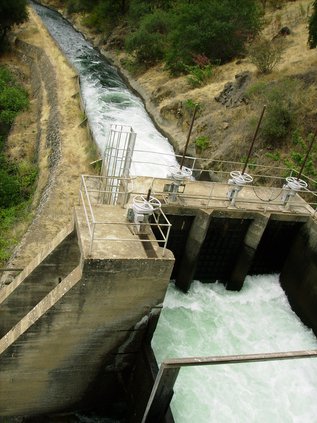The weakest link in keeping water flowing to 56,000 acres of farmland and through the faucets used by 170,000 people in Manteca, Lathrop and Tracy is a 110-year-old, 3.6-mile precariously perched open canal hugging the Stanislaus River canyon below Goodwin Dam.
The joint supply canal that carries all of the water used by the South San Joaquin Irrigation District and a portion of water that supplies Oakdale Irrigation District farmland has had four major disruptions since 1950 when landslides cut off water flow. The worst — in terms of disruption— delayed the start of the 1995 irrigation season for SSJID customers until April 29 of that year.
The SSJID is now exploring an option that would replace an open 15-foot wide and 15-foot deep canal as well as four tunnels that transverse large swaths of unstable canyon walls with a new tunnel covering the entire 3.6-mile distance in order to assure reliability of water supplies.
The solution won’t be cheap.
The cost of a replacement tunnel could run as high as $30 million.
SSJID Department of Engineering Manager Forest Killigsworth told Manteca Rotarians meeting Thursday at Ernie’s Rendezvous Room that the district looked at 24 options including rerouting water through the East Stockton Water District, upgrading the existing canal and tunnels, and replacing the entire joint supply canal with a new tunnel.
“The new tunnel option was the best alternative,” Killingsworth said in terms of assuring water reliability.
The weakest link in the water system that starts collecting snow runoff 95 miles northeast of Manteca on the western slope of the 11,460-foot Sonora Peak — the highest point on the Stanislaus River watershed — starts after collected water passes through Donnells, Beardsley, New Melones, and Tulloch reservoirs and reaches Goodwin Dam above Knights Ferry. It is at Goodwin Dam where the joint supply canal water carries water above the river on the canyon’s northern wall and a second OID supply canal runs along the southern edge.
It takes water 24 hours after it leaves Goodwin Dam to reach the farthest irrigated farm in Division 9 west of Ripon and south of Manteca that is served by the much heralded state-of-the-art pressurized delivery system that has significantly reduced water use increased crop yields, eliminated the need for air polluting gas generators, and has reversed the encroachment of salinity in the underground aquifer.
The joint supply canal is capable of moving 1,200 cubic feet of water a second or the equivalent volume of water 1,200 basketballs passing a set point could carry.
Water bound for SSJID farms and the cities of Manteca, Lathrop and Tracy splits away after 3.6 miles and enters the 9.7-mile upper main supply that has nine tunnels, 6.6 miles of lined canals and 2.1 miles of unlined canals. At one point the water drop is far and fast enough to support the in-district Frankenheimer hydroelectric plant capable of generating 5.3 megawatts of power. A nearly century-old flume that ran for 2,000 feet as part of the upper supply canal was replaced with pipe.
The water then flows into Woodward Reservoir that was put in place in 1916 and can store 32,764 square feet of water or enough water for almost two irrigation runs.
The entire 6.3 miles of lower main canal is unlined and represents another challenge the SSJID intends to eventually address. Landowners have encroached on the SSJID right-of-way plus the unlined canals mean there is significant seepage.
Next is the 12.1-mile main district canal that is completely unlined that supplies 23 distribution canals that serve farms.
Erosion of the canal is an issue along the 12.1-mile section that also has seepage.
The district has pondered whether to line the canals eventually to reduce water lose or to pressurize part or all of district as they have Division 9. It is an expensive proposition that also would trigger other issues given eliminating seepage and evaporation would significantly reduce water loss but it would also eliminate what is considered a main way of recharging the underground water table.
Not only would a pressurized system eliminate canal seepage and evaporation but it would do the same thing on farms by eliminating flood irrigation.
To contact Dennis Wyatt, email dwyatt@mantecabulletin.com





